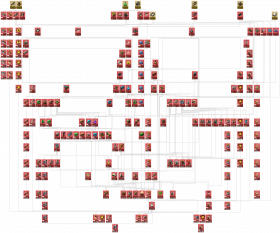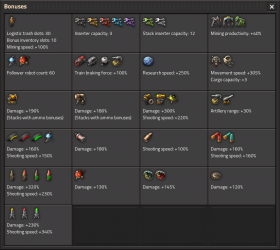User:Takenm/Technologies/ja
テクノロジーは研究所でサイエンスパックを使って研究することができます。
すべてのテクノロジーは、研究に必要なサイエンスパックの種類に対し一定量のサイエンスパックが必要です。例えば物流学テクノロジーでは、研究のためにテクノロジーが選択されている間、研究室に20個の自動化サイエンスパックを渡す必要があります。
実績

|
技術マニア すべてのテクノロジーを研究する |
- 技術マニアには無限研究テクノロジーの完了は1つのレベルも必要ありません。無限研究テクノロジーの内、無限でないレベルの技術はすべて必要です。
Infinite technologies
While most technologies in Factorio are either one-off or have a finite, relatively small number of levels available, a few are "infinite", meaning the player can research as many levels as they can afford. All of them unlock bonuses to existing technologies, never new structures or abilities. The per-level bonuses are constant for a particular infinite technologies and, like finite research bonuses, are additive within a single technology. They are subject to diminishing returns; thus, the per-level and per-science pack contributions from very high levels of infinite technologies will eventually provide only marginal improvements.
All infinite technologies levels require space science packs, and are also the only technologies that do. As such, they are late-game technologies intended primarily for players who wish to continue playing and expand their factory past the nominal victory condition of launching a rocket.
Infinite technologies are identified in-game by a small ∞ infinity symbol shown in the top right corner of the research technology's card in the research screen.
Most infinite technologies are continuations of ordinary multi-level technologies; the "infinite" mechanic becomes effective once the player reaches the card initially labeled with N - ∞ in the research tree. Only the two artillery-related technologies (artillery shell range and shooting speed) are infinite-only; for these, 1 - ∞ is shown before any levels in them are researched. In either case, once the first infinite level is researched, the card label switches to the one discussed above.
Pricing formulas
The price of all infinite technologies is generated in a mathematical progression; for the majority of technologies, the progression is geometric, mostly in powers of 2. Two technologies - mining productivity and follower robot count - use an arithmetic progression instead.
The table below summarizes for all infinite researches their first infinite level, the cost of the first infinite level, the cost formula and the per-level bonus.
We denote by N the current level of the research, by F the final non-infinite level of the research (hence F+1 is the first "infinite" level) and by P[N] the price of the research at level N.
| Technology | Science Packs | F+1 | P[F+1] | P[N] | Bonus |
|---|---|---|---|---|---|
| Worker robot speed | 7 | 1,000 | 1,000 × 2^(N - F - 1) | +65% Robot Speed | |
| Mining productivity | 4 | 2,500 | 2,500 × (N - F) | +10% Mining Productivity | |
| Physical projectile damage | 7 | 1,000 | 1,000 × 2^(N - F - 1) | +40% Bullet Damage +70% Turret Damage +40% Shotgun Shell Damage +100% Cannon Shell Damage | |
| Stronger explosives | 7 | 1,000 | 1,000 × 2^(N - F - 1) | +50% Rocket Damage +20% Grenade Damage +20% Landmine Damage | |
| Refined flammables | 7 | 1,000 | 1,000 × 2^(N - F - 1) | +20% Flame Thrower Damage | |
| Energy weapons damage | 7 | 1,000 | 1,000 × 2^(N - F - 1) | +70% Laser Turret Damage +30% Combat Robot Beam/Laser Damage | |
| Artillery shell range | 1 | 1,000 | 1,000 × 2^(N - F) | +30% Artillery Shell Range | |
| Artillery shell speed | 1 | 1,000 | 1,000 + 1,000 × 3^(N - F - 1) | +100% Artillery Speed | |
| Follower robot count | 7 | 1,000 | 100 × (N - F) + 900 | +10 Follower Robots |
Cumulative cost
As the price of most infinite technologies (specifically, those based on geometric progressions) increases very steeply, it may be a good idea for players to set realistic target levels for each of the infinite technologies they wish to pursue, and make their factory plans accordingly. To that end, the following properties of cumulative infinite research prices may be useful:
- For infinite technologies whose underlying equation is a powers-of-two geometric series, the cumulative price of the first
N - Finfinite levels (skipping the firstFlevel, so counting "infinite" levels only) is2 × P[N] - P[F+1]; i.e., twice the price of the final researched level, less the price of the first "infinite" level.- As N increases, this is approximated well by
2 × P[N] = P[N+1], so the cumulative cost of researching to levelNis about as much as researching levelN+1. - If one decides a level
Mwhich one considers the "highest feasible" with their current science pack production capacity, expanding said capacity by a factor ofXwill allow aboutlog[2](X)additional levels to be researched before the next level takes longer to research with the expanded capacity than levelM + 1would have taken with the pre-expansion production capacity. - For example, if one expands production capacity by a factor of 10, they will be able to research at least
floor(log[2](10)) = 3and at mostceiling(log[2](10)) = 4additional levels in a given technology before the exponential increase in price negates the speed benefits of their ×10 capacity expansion.
- As N increases, this is approximated well by
- The cumulative price of the first
N - Flevels of infinite technologies whose underlying equation is an arithmetic series is(N - F) × (P[N] + P[F + 1]) ÷ 2; i.e,N - Ftimes the mean of the prices of the first and last "infinite" level. For the Follower robot count (research), an additional900 × (N-F)need to be added.- Expanding production capacity by a factor of
X, as above, will in this case allow an additionalN × (X - 1)levels to be researched before the benefit of the expansion is wiped out (i.e., research progress speed drops to or below what it was pre-expansion).
- Expanding production capacity by a factor of
- The cumulative price of the first N levels of artillery shell shooting speed, the sole infinite technology whose underlying equation is a powers-of-three geometric series (equation type (2)) is
1.5 × P[N] - 0.5 × P[1]; i.e., 1.5 times the price of the final researched level, less half the price of the first level.
Note that these prices reflect research units, which will not be equal to science packs if productivity modules are used in labs. (In that case, the science pack requirement will be lower.)

